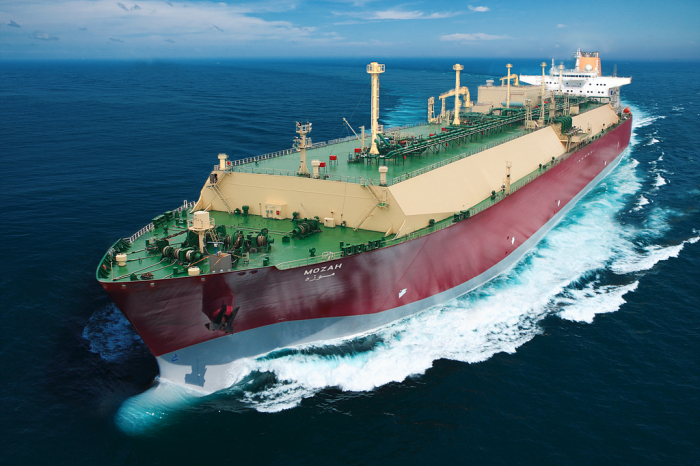
A Q-Max LNG carrier built by Samsung Heavy Industries in 2008 (Courtesy of Samsung Heavy Industries) Orders for mega liquefied natural gas carriers re-emerged as demand for the gas increased to cut carbon emissions. South Korea’s top three shipbuilders - Korea Shipbuilding & Offshore Engineering Co. (KSOE), Daewoo Shipbuilding & Marine Engineering Co. and Samsung Heavy Industries Co. – are expected to dominate the market since they are the only shipyards around the world that have built such tankers worth about 300 billion won ($248 million) each.The Korean Big Three have won deals to manufacture eight LNG tankers so far this month, according to industry sources on Wednesday. Among the total, six vessels have LNG capacities of larger than 200,000 cubic meters with KSOE, under Hyundai Heavy Industries Group, and Daewoo scheduled to deliver three each.That compared with the 2019-2021 period when South Korean shipbuilders had secured orders to build only six vessels of the size.The price of six LNG carriers with capacities of larger than 200,000 cubic meters that KSOE and Daewoo will build is about 280 billion-290 billion won per ship, about 40 billion won higher than the price of a tanker with a capacity of 174,000 tons.WEAK DEMAND AFTER LATE 2000SLNG ships are classified into conventional size carriers with a capacity of about 175,000-180,000 cubic meters, Q-Flex tankers with a capacity of some 210,000 cubic meters and Q-Max vessels with a capacity of about 260,000 cubic meters. Q stands for Qatar since the country in the Middle East sought such mega tankers in the early 2000s when it started major LNG production projects.About 30 Q-Max and Q-Flex tankers were ordered until the late 2000s, but few had looked for the mega carriers since then. They are more competitive than conventional size ships because they can load more, but there are not many ports for those mega carriers can dock.Ships of Q-Max and Q-Flex sizes are 310-350 meters long and measure more than 50 meters wide, similar to three or four soccer fields. They are 20-30% larger than the conventional size carriers that have been the standard model for large LNG vessels for more than a decade. A Q-Flex LNG tanker built by Hyundai Heavy Industries in 2009 (Courtesy of KSOE) ERA OF LNGOrders for Q-Max and Q-Flex carriers were increasing in line with the growing demand for LNG as an eco-friendly fuel. Global LNG demand is forecast to nearly double to 700 million tons in 2040 from 380 million tons last year, according to energy major Shell.Europe is also expected to seek more waterborne natural gas supplies in a move to cut reliance on Russia for the energy resources following its invasion of Ukraine. That will ramp up demand for mega LNG carriers.South Korean shipbuilders reportedly secured orders this year to build six tankers that will carry LNG cargo produced from US shale gas. Qatar, scheduled to order more than 100 LNG ships by 2027, is expected to seek tankers with capacities of larger than 200,000 cubic meters mostly.“The world is actively constructing port infrastructure for mega tankers,” said a South Korean shipping industry source. “Given rising fuel costs, orders for mega vessels are predicted to grow further.”The Big Three will be key beneficiaries, given their unrivaled technology for LNG carriers, industry sources said.“The Big Three are the only shipbuilders that have experience in building such mega tankers. They will take most of the orders,” said a local shipbuilding industry source.By Jung-hwan Hwangjung@hankyung.comJongwoo Cheon edited this article.
Most Read